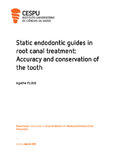| dc.contributor.advisor | BERNARDINO, PEDRO JORGE RODRIGUES DE CARVALHO | |
| dc.contributor.author | Ploué, Agathe Louise | |
| dc.date.accessioned | 2023-11-24T13:23:36Z | |
| dc.date.available | 2023-11-24T13:23:36Z | |
| dc.date.issued | 2023 | |
| dc.identifier.uri | http://hdl.handle.net/20.500.11816/4467 | |
| dc.description.abstract | Introdução: A criação da cavidade de acesso é o primeiro e mais crucial passo no tratamento endodôntico. Embora possa ser frustrante e difícil, especialmente no tratamento de canais ou dentes calcificados com morfologias particulares. A endodontia guiada surgiu como uma alternativa viável para alcançar maior precisão e precisão nos procedimentos endodônticos.
Objectivo: Comparar as cavidades de acesso feitas com a técnica convencional ou feitas com uma guia endodôntica estática e avaliar a precisão e a conservação da estrutura dentária.
Métodos: Foi realizada uma pesquisa electrónica baseada em palavras-chave na base de dados PubMed. Os artigos publicados nos últimos 10 anos em língua inglesa e com texto integral disponível foram os critérios de inclusão utilizados.
Resultados : Dos 14 artigos seleccionados, 7 estudos discutem a precisão das guias endodônticas e a localização dos canais, 5 estudos compararam a preservação da estrutura dentária entre uma cavidade de acesso convencional e guiado e 2 artigos comparam a eficácia e abordam a resistência à fractura entre as técnicas convencionais e guiadas.
Conclusão: O resultado deste estudo indica que a endodontia guiada é um método seguro, simples e eficiente que mostra uma exactidão aceitável. Permitem a preservação de estruturas dentárias que são superiores às técnicas convencionais. Podem ser utilizados em tratamentos endodônticos mais complicados, tais como canais radiculares calcificados. No entanto, este método tem certas limitações e desvantagens. | pt_PT |
| dc.description.abstract | Introduction: Creating the access cavity is the first and most crucial step in endodontic treatment. While it can be frustrating and difficult, especially when treating calcified canals or teeth with particular morphologies. Guided endodontics has emerged as a viable alternative for achieving greater accuracy and precision in endodontic procedures.
Objective: Compare access cavities made with the conventional technique or made with a static endodontic guide and evaluate the accuracy and the conservation of tooth structure.
Methods: An electronic keyword-based search was performed on the PubMed database. Articles published in the last 10 years in English language and with full-text available were the inclusion criteria used.
Results: Of the 14 articles selected, 7 studies discuss the accuracy of endodontic guides and location of canals, 5 studies compared tooth structure preservation between a conventional and guided access cavity and 2 papers compare the efficacy and address the resistance to fracture between the conventional and guided techniques.
Conclusion: The result of this study indicates that guided endodontics is a secure, simple and efficient method that show an acceptable accuracy. They allow for the preservation of dental structures that are superior to conventional techniques. They can be used in more complicated endodontic treatments such as calcified root canals. However, this method has certain limitations and disadvantages. | pt_PT |
| dc.language.iso | eng | pt_PT |
| dc.rights | info:eu-repo/semantics/openAccess | pt_PT |
| dc.subject | Endodontic access | pt_PT |
| dc.subject | Endodontic treatments | pt_PT |
| dc.subject | Limitations | pt_PT |
| dc.subject | CBCT | pt_PT |
| dc.subject | Guided endodontic access | pt_PT |
| dc.title | Static endodontic guides in root canal treatment: Accuracy and conservation of the tooth | pt_PT |
| dc.type | info:eu-repo/semantics/masterThesis | pt_PT |
| dc.identifier.tid | 203356985 | pt_PT |
| thesis.degree.name | Mestrado em Medicina Dentária | pt_PT |

